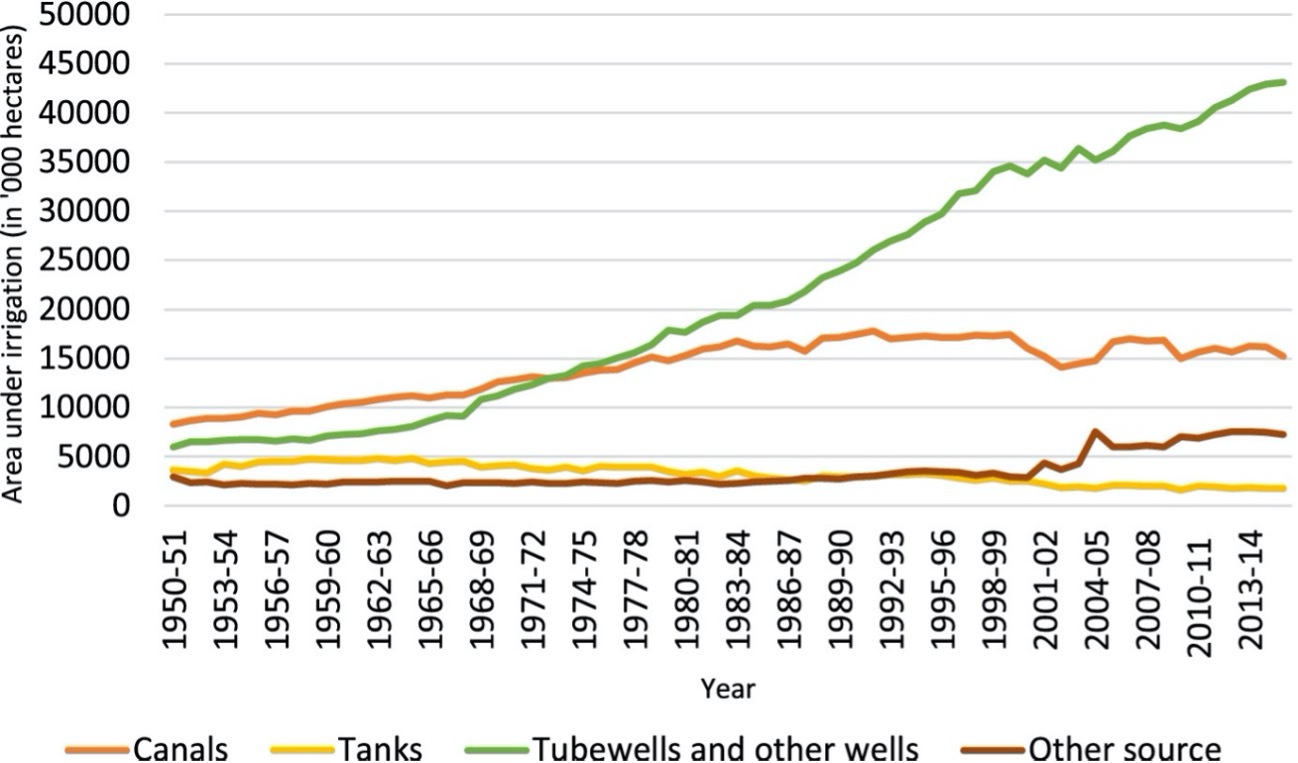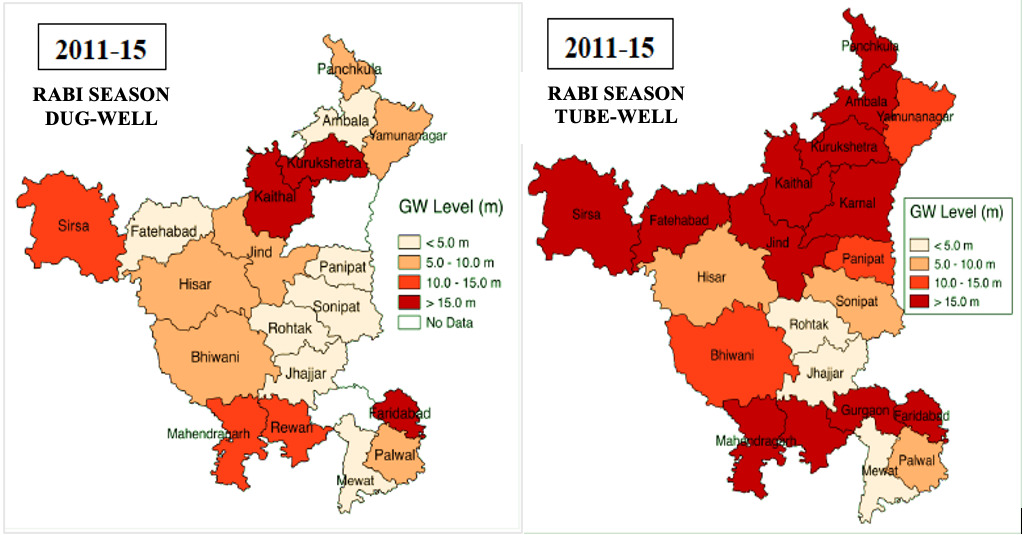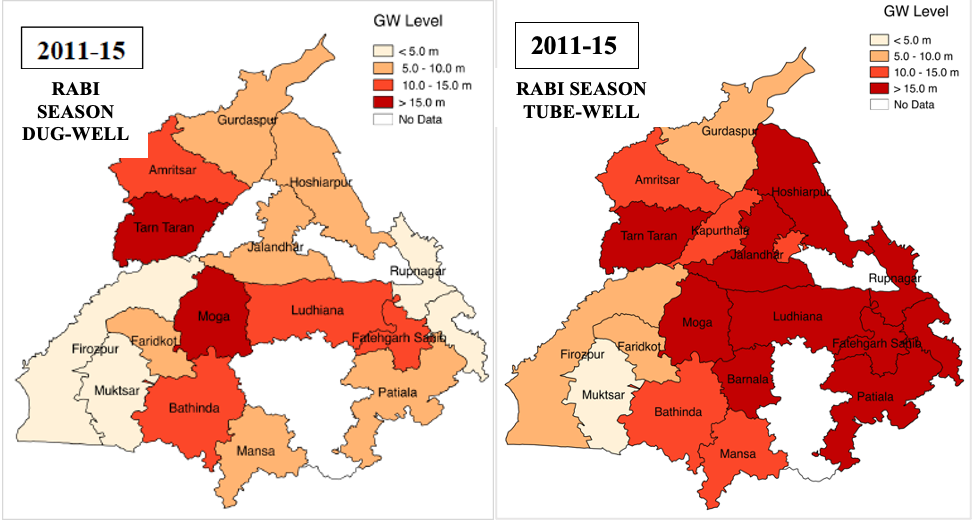Blog // Groundwater depletion in Punjab and Haryana through the lense of the Water-Energy-Food Nexus
By Harnoor Kaur. Despite receiving normal precipitation levels, north-western India has emerged as a hotspot for groundwater depletion. This phenomenon requires us to question what is aggravating groundwater depletion in a region that includes the states of Punjab and Haryana – the Granary of India. This article will trace the link between the current state of groundwater depletion, and the water, energy, and food related policies contributing to the deteriorating groundwater situation in Punjab and Haryana. The intricate relationship between water-energy-food offers a primary point of reference, as it highlights the acute groundwater deficit in Punjab and Haryana. This has been influenced by two factors: incentivised groundwater pumping and guaranteed procurement of wheat-rice crops.

Of Punjab's 4.4 million hectares of cropland, 85 percent is irrigated with groundwater. Punjabi farmers have installed more than 1.2 million wells to irrigate their fields since the mid-1960s, and about 20,000 new wells are added annually - Circle of Blue
Highlights
- The groundwater development rate in Punjab and Haryana is higher than the national average of India at 135% and 149% respectively.
- Intensive groundwater extraction has occurred following subsidised or flat-rate tariff electricity, which has ensured the production of cereals (wheat-rice crops).
- Energy and food policies have further incentivised extensive use of electric tube wells, contributing to the rise of unregulated groundwater markets in the north-western region.
Groundwater Use
India uses approximately 230 km3 of groundwater, which makes it the world’s largest user of groundwater. The recent Gravity Recovery and Climate Experiment (GRACE) groundwater anomalies indicate a concerning pattern of groundwater depletion in north-western India. Overall, 90% of the groundwater extracted is used for irrigation, which is supported by supply-driven policies. In India, water, energy and agriculture are bound in a system of mutual dependence. To ensure growth within the agricultural sector, individual states rely on unsustainable groundwater extraction, subsidised electricity supply, and guaranteed production of crops. In Punjab and Haryana, agriculture has stimulated a groundwater development rate of 149% and 135% respectively, which poses a threat to food and water security in the region. So how did we reach this point?
Groundwater Ownership
Under the Common Law Principles, a landowner has de facto ownership of the groundwater below their land. With the advent of the Green Revolution and consequential lower drilling prices, farmers found investment in groundwater irrigation structures to be worthwhile. The emergence of groundwater markets throughout Punjab and Haryana has brought benefits to small and marginal farmers across the region, but these have come at a price. Unregulated markets have resulted in the over-drafting of groundwater resources by rich farmers, and have exposed small and marginal farmers to unfair prices.
The Energy-Irrigation Nexus
Fig.1 illustrates the main sources of irrigation in India. Prior to the 1970s, canals and water tanks were the main sources of irrigation across the country, however, the expansion of canal irrigation was limited due to bureaucratic and design failures. Meanwhile, there was an uptake in private groundwater pumping due to its reliability. Between the 1980s and 2010s, demand for diesel and petrol increased six-fold as such are required to pump groundwater. The adoption of private groundwater tube wells was influenced by subsidised electricity.

Power supply to farmers is heavily subsidised and unmetered in most states of India, including in Punjab and Haryana. At a national level, Haryana and Punjab offer the largest power subsidy to the agricultural sector with 5,284 and 4,454 INR Crores respectively. Currently, the Punjab State Electricity Board relies on other states to meet the demands of its agricultural sector. The free-farm electricity structure has created an incentive for a wheat-rice cropping system, despite diminishing returns and depleting groundwater resources. The upsurge in groundwater depletion has been more evident in Punjab and Haryana, at 69.11% and 55.08% respectively, because they have a higher proportion of medium and large land holdings. Subsequently, Punjab and Haryana have exceeded their potential for installing electric water pumps by 250,000 and 100,000 pumps respectively. Excessive groundwater extraction has created zones where the volume pumped by electricity-operated tube-wells exceeds aquifers’ potentials.
The Agriculture-Irrigation Nexus
Punjab and Haryana witnessed a shift from a diversified cropping system to a cereal-based crop system in the 1970s, particularly growing wheat-rice crops, which was made possible by the lucrative food procurement system in place. The agricultural procurement policy adopted by Punjab and Haryana offers a Minimum Support Price (MSP), which is higher than the market price for cereals, such as wheat and paddy. In addition to MSP, storage facilities offered by the Food Corporation of India have kept the wheat-rice, water-intensive cropping popular among farmers. In Punjab and Haryana, the production of wheat/rice was substantially higher than the national average in 2015 (+49%/65%) and 2016 (42%/28%).
Punjab and Haryana’s Current State
The agricultural procurement policy and electricity subsidies have acted as an impetus for mindless groundwater extraction in the region. When the current groundwater levels were examined between 1996-2015, using well-types as a variable, it was identified that tube-wells have a bigger impact on groundwater depletion than hand dug-wells. However, there was no significant difference in the impact of wheat and rice cultivation intensity on groundwater levels in either the Rabi or Kharif seasons (figure 2 and 3); both are equally damaging. Furthermore, groundwater exploitation in Punjab has been analogous to that of Haryana. There is a need for a local contingency plan that focuses on promoting demand-based policies such as volumetric pricing, metering, and crop diversification to counter groundwater depletion.


To summarise, the water-energy-food nexus explicitly highlights the interlinkages between groundwater depletion, food security, and electricity tariffs in north-western India. Access to highly subsidized energy, guaranteed food procurement and ill-informed water groundwater policies underscore dysfunctional associations between these three sectors in Punjab and Haryana.
This article was originally published on the website of WaterSciencePolicy and was republished with the kind permission of the author.
About the author
Harnoor studied MSc in Water Science, Policy & Management at the University of Oxford. Her research interests lie in drought management, discourse analysis and water-energy-food nexus.
Related articles
- Publication // Sustainable Groundwater Management in India Needs a Water-Energy-Food Nexus Approach
- Publication // Mapping Policy for Solar Irrigation Across the Water-Energy-Food (WEF) Nexus in India
- Study // Solarising Groundwater Irrigation in India: A Growing Debate
